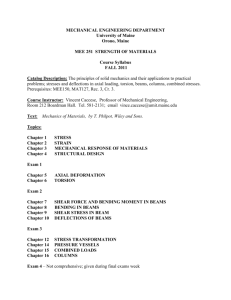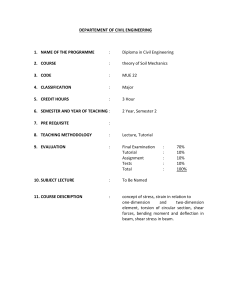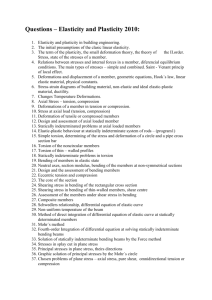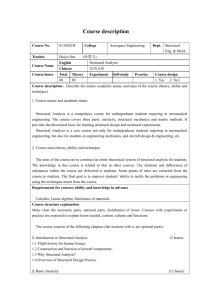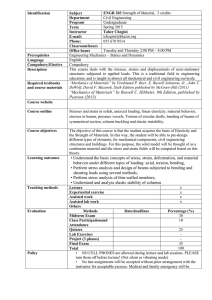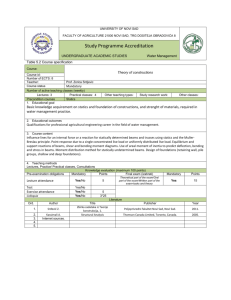Tutorial
advertisement
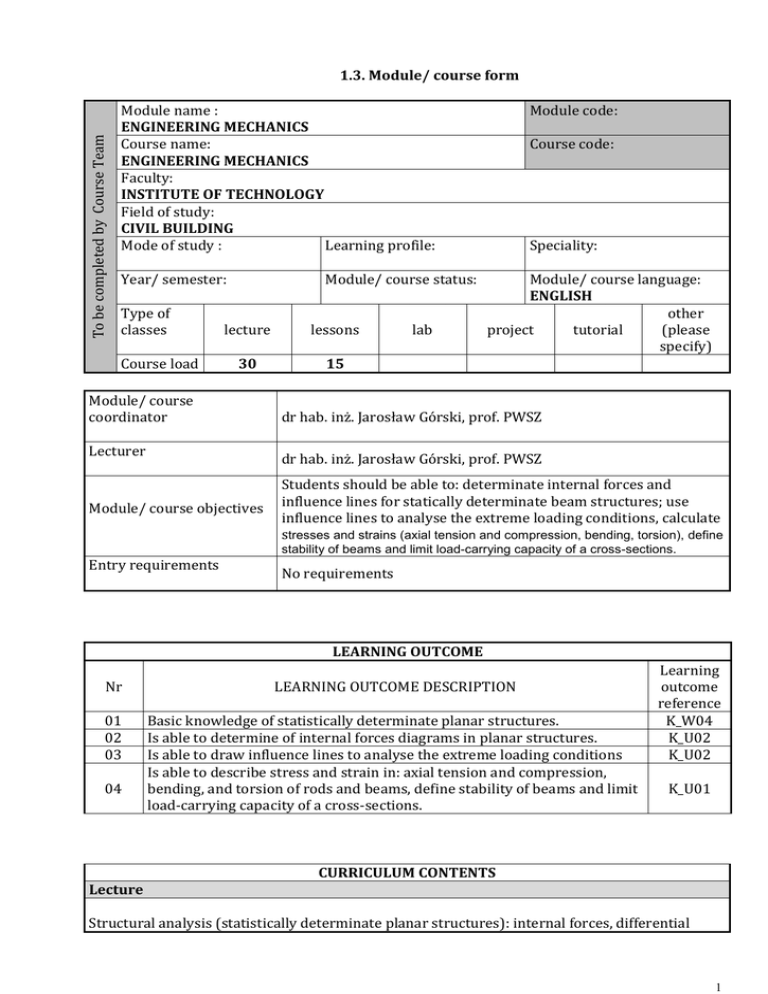
To be completed by Course Team 1.3. Module/ course form Module name : ENGINEERING MECHANICS Course name: ENGINEERING MECHANICS Faculty: INSTITUTE OF TECHNOLOGY Field of study: CIVIL BUILDING Mode of study : Learning profile: Year/ semester: Type of classes Course load Module/ course status: lecture lessons 30 15 Module/ course coordinator Lecturer lab Module code: Course code: Speciality: Module/ course language: ENGLISH other project tutorial (please specify) dr hab. inż. Jarosław Górski, prof. PWSZ dr hab. inż. Jarosław Górski, prof. PWSZ Module/ course objectives Students should be able to: determinate internal forces and influence lines for statically determinate beam structures; use influence lines to analyse the extreme loading conditions, calculate stresses and strains (axial tension and compression, bending, torsion), define stability of beams and limit load-carrying capacity of a cross-sections. Entry requirements No requirements LEARNING OUTCOME Nr LEARNING OUTCOME DESCRIPTION 01 02 03 Basic knowledge of statistically determinate planar structures. Is able to determine of internal forces diagrams in planar structures. Is able to draw influence lines to analyse the extreme loading conditions Is able to describe stress and strain in: axial tension and compression, bending, and torsion of rods and beams, define stability of beams and limit load-carrying capacity of a cross-sections. 04 Learning outcome reference K_W04 K_U02 K_U02 K_U01 CURRICULUM CONTENTS Lecture Structural analysis (statistically determinate planar structures): internal forces, differential 1 equations of equilibrium, determination of reactions and internal forces in beams, frames, threehinged systems, trusses and complex systems, influence lines of reactions and internal forces for beams, frames and trusses, extreme loading. Strength of materials: definitions of stress and strain; plane stress and plane strain, Hooke’s law (constitutive relations), axial tension and compression), uniaxial and biaxial bending, bending with tension/compression, free torsion of rods, shear stresses at bending, joints of structural elements; compound and multiple beams, composite beams (tension/compression, bending), deflection line of a beam (Euler’s equation), stability of beams, strength criteria, equivalent stresses, limit load-carrying capacity of a cross-section (axial tension/compression, bending, tension/compression with bending). Tutorial Solving problem related to: structural analysis and strength of materials. Basic literature Additional literature 1. Hibbeler R.C. Mechanics of materials. Printice Hall 1997. 2. Hibbeler R.C. Structural analysis. Printice Hall 1995. 1. Carpinteri A. Structural mechanics. A unified approach. E & FN Spon 1997 2. Callister W.D. Materials science and engineering. John Wiley&Sons 2000 3. Meriam J.L., Kraige, L.G., Engineering Mechanics. Statics. John Wiley & Sons 1998 Lecture, discussion Teaching methods Learning outcome number Assessment method Written exam Form and terms of an exam 01,02,03,04 Written exam STUDENT WORKLOAD Participation in lectures Independent study of lecture topics Participation in tutorials, labs, projects and seminars Independent preparation for tutorials* Preparation of projects/essays/etc. * Preparation/ independent study for exams Participation during consultation hours Other TOTAL student workload in hours Number of ECTS credit per course unit Number of ECTS credit associated with practical classes Number of hours 30 35 15 15 30 2 127 5 1,2 2 Number of ECTS for classes that require direct participation of professors 1,5 3

